#onmyodo
Text
Shikigami and onmyōdō through history: truth, fiction and everything in between
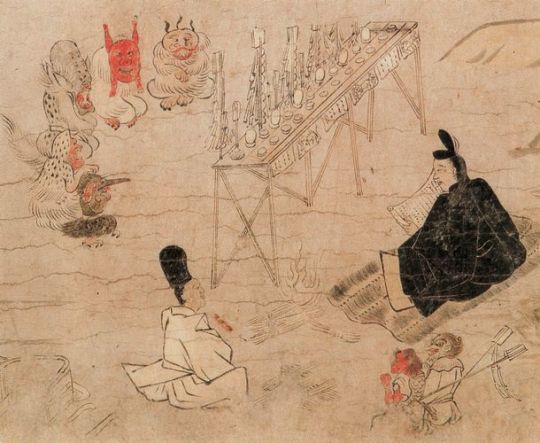
Abe no Seimei exorcising disease spirits (疫病神, yakubyōgami), as depicted in the Fudō Riyaku Engi Emaki. Two creatures who might be shikigami are visible in the bottom right corner (wikimedia commons; identification following Bernard Faure’s Rage and Ravage, pp. 57-58)
In popular culture, shikigami are basically synonymous with onmyōdō. Was this always the case, though? And what is a shikigami, anyway? These questions are surprisingly difficult to answer. I’ve been meaning to attempt to do so for a longer while, but other projects kept getting in the way. Under the cut, you will finally be able to learn all about this matter.
This isn’t just a shikigami article, though. Since historical context is a must, I also provide a brief history of onmyōdō and some of its luminaries. You will also learn if there were female onmyōji, when stars and time periods turn into deities, what onmyōdō has to do with a tale in which Zhong Kui became a king of a certain city in India - and more!
The early days of onmyōdō
In order to at least attempt to explain what the term shikigami might have originally entailed, I first need to briefly summarize the history of onmyōdō (陰陽道). This term can be translated as “way of yin and yang”, and at the core it was a Japanese adaptation of the concepts of, well, yin and yang, as well as the five elements. They reached Japan through Daoist and Buddhist sources. Daoism itself never really became a distinct religion in Japan, but onmyōdō is arguably among the most widespread adaptations of its principles in Japanese context.

Kibi no Makibi, as depicted by Yoshitoshi Tsukioka (wikimedia commons)
It’s not possible to speak of a singular founder of onmyōdō comparable to the patriarchs of Buddhist schools. Bernard Faure notes that in legends the role is sometimes assigned to Kibi no Makibi, an eighth century official who spent around 20 years in China. While he did bring many astronomical treatises with him when he returned, this is ultimately just a legend which developed long after he passed away.
In reality onmyōdō developed gradually starting with the sixth century, when Chinese methods of divination and treatises dealing with these topics first reached Japan. Early on Buddhist monks from the Korean kingdom of Baekje were the main sources of this knowledge. We know for example that the Soga clan employed such a specialist, a certain Gwalleuk (観勒; alternatively known under the Japanese reading of his name, Kanroku).
Obviously, divination was viewed as a very serious affair, so the imperial court aimed to regulate the continental techniques in some way. This was accomplished by emperor Tenmu with the formation of the onmyōryō (陰陽寮), “bureau of yin and yang” as a part of the ritsuryō system of governance. Much like in China, the need to control divination was driven by the fears that otherwise it would be used to legitimize courtly intrigues against the emperor, rebellions and other disturbances.
Officials taught and employed by onmyōryō were referred to as onmyōji (陰陽師). This term can be literally translated as “yin-yang master”. In the Nara period, they were understood essentially as a class of public servants. Their position didn’t substantially differ from that of other specialists from the onmyōryō: calendar makers, officials responsible for proper measurement of time and astrologers. The topics they dealt with evidently weren’t well known among commoners, and they were simply typical members of the literate administrative elite of their times.
Onmyōdō in the Heian period: magic, charisma and nobility
The role of onmyōji changed in the Heian period. They retained the position of official bureaucratic diviners in employ of the court, but they also acquired new duties. The distinction between them and other onmyōryō officials became blurred. Additionally their activity extended to what was collectively referred to as jujutsu (呪術), something like “magic” though this does not fully reflect the nuances of this term. They presided over rainmaking rituals, purification ceremonies, so-called “earth quelling”, and establishing complex networks of temporal and directional taboos.

A Muromachi period depiction of Abe no Seimei (wikimedia commons)
The most famous historical onmyōji like Kamo no Yasunori and his student Abe no Seimei were active at a time when this version of onmyōdō was a fully formed - though obviously still evolving - set of practices and beliefs. In a way they represented a new approach, though - one in which personal charisma seemed to matter just as much, if not more, than official position. This change was recognized as a breakthrough by at least some of their contemporaries. For example, according to the diary of Minamoto no Tsuneyori, the Sakeiki (左經記), “in Japan, the foundations of onmyōdō were laid by Yasunori”.
The changes in part reflected the fact that onmyōji started to be privately contracted for various reasons by aristocrats, in addition to serving the state. Shin’ichi Shigeta notes that it essentially turned them from civil servants into tradespeople. However, he stresses they cannot be considered clergymen: their position was more comparable to that of physicians, and there is no indication they viewed their activities as a distinct religion. Indeed, we know of multiple Heian onmyōji, like Koremune no Fumitaka or Kamo no Ieyoshi, who by their own admission were devout Buddhists who just happened to work as professional diviners.
Shin’ichi Shigeta notes is evidence that in addition to the official, state-sanctioned onmyōji, “unlicensed” onmyōji who acted and dressed like Buddhist clergy, hōshi onmyōji (法師陰陽師) existed. The best known example is Ashiya Dōman, a mainstay of Seimei legends, but others are mentioned in diaries, including the famous Pillow Book. It seems nobles particularly commonly employed them to curse rivals. This was a sphere official onmyōji abstained from due to legal regulations. Curses were effectively considered crimes, and government officials only performed apotropaic rituals meant to protect from them.
The Heian period version of onmyōdō captivated the imagination of writers and artists, and its slightly exaggerated version present in classic literature like Konjaku Monogatari is essentially what modern portrayals in fiction tend to go back to.
Medieval onmyōdō: from abstract concepts to deities

Gozu Tennō (wikimedia commons)
Further important developments occurred between the twelfth and fourteenth centuries. This period was the beginning of the Japanese “middle ages” which lasted all the way up to the establishment of the Tokugawa shogunate. The focus in onmyōdō in part shifted towards new, or at least reinvented, deities, such as calendarical spirits like Daishōgun (大将軍) and Ten’ichijin (天一神), personifications of astral bodies and concepts already crucial in earlier ceremonies. There was also an increased interest in Chinese cosmological figures like Pangu, reimagined in Japan as “king Banko”. However, the most famous example is arguably Gozu Tennō, who you might remember from my Susanoo article.
The changes in medieval onmyōdō can be described as a process of convergence with esoteric Buddhism. The points of connection were rituals focused on astral and underworld deities, such as Taizan Fukun or Shimei (Chinese Siming). Parallels can be drawn between this phenomenon and the intersection between esoteric Buddhism and some Daoist schools in Tang China. Early signs of the development of a direct connection between onmyōdō and Buddhism can already be found in sources from the Heian period, for example Kamo no Yasunori remarked that he and other onmyōji depend on the same sources to gain proper understanding of ceremonies focused on the Big Dipper as Shingon monks do.
Much of the information pertaining to the medieval form of onmyōdō is preserved in Hoki Naiden (ほき内伝; “Inner Tradition of the Square and the Round Offering Vessels”), a text which is part divination manual and part a collection of myths. According to tradition it was compiled by Abe no Seimei, though researchers generally date it to the fourteenth century. For what it’s worth, it does seem likely its author was a descendant of Seimei, though.
Outside of specialized scholarship Hoki Naiden is fairly obscure today, but it’s worth noting that it was a major part of the popular perception of onmyōdō in the Edo period. A novel whose influence is still visible in the modern image of Seimei, Abe no Seimei Monogatari (安部晴明物語), essentially revolves around it, for instance.
Onmyōdō in the Edo period: occupational licensing
Novels aside, the first post-medieval major turning point for the history of onmyōdō was the recognition of the Tsuchimikado family as its official overseers in 1683. They were by no means new to the scene - onmyōji from this family already served the Ashikaga shoguns over 250 years earlier. On top of that, they were descendants of the earlier Abe family, the onmyōji par excellence. The change was not quite the Tsuchimikado’s rise, but rather the fact the government entrusted them with essentially regulating occupational licensing for all onmyōji, even those who in earlier periods existed outside of official administration.
As a result of the new policies, various freelance practitioners could, at least in theory, obtain a permit to perform the duties of an onmyōji. However, as the influence of the Tsuchimikado expanded, they also sought to oblige various specialists who would not be considered onmyōji otherwise to purchase licenses from them. Their aim was to essentially bring all forms of divination under their control. This extended to clergy like Buddhist monks, shugenja and shrine priests on one hand, and to various performers like members of kagura troupes on the other.
Makoto Hayashi points out that while throughout history onmyōji has conventionally been considered a male occupation, it was possible for women to obtain licenses from the Tsuchimikado. Furthermore, there was no distinct term for female onmyōji, in contrast with how female counterparts of Buddhist monks, shrine priests and shugenja were referred to with different terms and had distinct roles defined by their gender.
As far as I know there’s no earlier evidence for female onmyōji, though, so it’s safe to say their emergence had a lot to do with the specifics of the new system. It seems the poems of the daughter of Kamo no Yasunori (her own name is unknown) indicate she was familiar with yin-yang theory or at least more broadly with Chinese philosophy, but that’s a topic for a separate article (stay tuned), and it's not quite the same, obviously.
The Tsuchimikado didn’t aim to create a specific ideology or systems of beliefs. Therefore, individual onmyōji - or, to be more accurate, individual people with onmyōji licenses - in theory could pursue new ideas. This in some cases lead to controversies: for instance, some of the people involved in the (in)famous 1827 Osaka trial of alleged Christians (whether this label really is applicable is a matter of heated debate) were officially licensed onmyōji. Some of them did indeed possess translated books written by Portuguese missionaries, which obviously reflected Catholic outlook. However, Bernard Faure suggests that some of the Edo period onmyōji might have pursued Portuguese sources not strictly because of an interest in Catholicism but simply to obtain another source of astronomical knowledge.
The legacy of onmyōdō
In the Meiji period, onmyōdō was banned alongside shugendō. While the latter tradition experienced a revival in the second half of the twentieth century, the former for the most part didn’t. However, that doesn’t mean the history of onmyōdō ends once and for all in the second half of the nineteenth century.
Even today in some parts of Japan there are local religious traditions which, while not identical with historical onmyōdō, retain a considerable degree of influence from it. An example often cited in scholarship is Izanagi-ryū (いざなぎ流) from the rural Monobe area in the Kōchi Prefecture. Mitsuki Ueno stresses that the occasional references to Izanagi-ryū as “modern onmyōdō” in literature from the 1990s and early 2000s are inaccurate, though. He points out they downplay the unique character of this tradition, and that it shows a variety of influences. Similar arguments have also been made regarding local traditions from the Chūgoku region.
Until relatively recently, in scholarship onmyōdō was basically ignored as superstition unworthy of serious inquiries. This changed in the final decades of the twentieth century, with growing focus on the Japanese middle ages among researchers. The first monographs on onmyōdō were published in the 1980s. While it’s not equally popular as a subject of research as esoteric Buddhism and shugendō, formerly neglected for similar reasons, it has nonetheless managed to become a mainstay of inquiries pertaining to the history of religion in Japan.
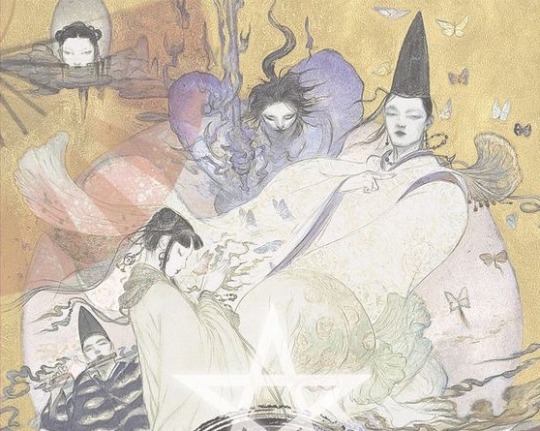
Yoshitaka Amano's illustration of Baku Yumemakura's fictionalized portrayal of Abe no Seimei (right) and other characters from his novels (reproduced here for educational purposes only)
Of course, it’s also impossible to talk about onmyōdō without mentioning the modern “onmyōdō boom”. Starting with the 1980s, onmyōdō once again became a relatively popular topic among writers. Novel series such as Baku Yumemakura’s Onmyōji, Hiroshi Aramata’s Teito Monogatari or Natsuhiko Kyōgoku’s Kyōgōkudō and their adaptations in other media once again popularized it among general audiences. Of course, since these are fantasy or mystery novels, their historical accuracy tends to vary (Yumemakura in particular is reasonably faithful to historical literature, though). Still, they have a lasting impact which would be impossible to accomplish with scholarship alone.
Shikigami: historical truth, historical fiction, or both?
You might have noticed that despite promising a history of shikigami, I haven’t used this term even once through the entire crash course in history of onmyōdō. This was a conscious choice. Shikigami do not appear in any onmyōdō texts, even though they are a mainstay of texts about onmyōdō, and especially of modern literature involving onmyōji.
It would be unfair to say shikigami and their prominence are merely a modern misconception, though. Virtually all of the famous legends about onmyōji feature shikigami, starting with the earliest examples from the eleventh century. Based on Konjaku Monogatari, there evidently was a fascination with shikigami at the time of its compilation. Fujiwara no Akihira in the Shinsarugakuki treats the control of shikigami as an essential skill of an onmyōji, alongside the abilities to “freely summon the twelve guardian deities, call thirty-six types of wild birds (...), create spells and talismans, open and close the eyes of kijin (鬼神; “demon gods”), and manipulate human souls”.
It is generally agreed that such accounts, even though they belong to the realm of literary fiction, can shed light on the nature and importance of shikigami. They ultimately reflect their historical context to some degree. Furthermore, it is not impossible that popular understanding of shikigami based on literary texts influenced genuine onmyōdō tradition. It’s worth pointing out that today legends about Abe no Seimei involving them are disseminated by two contemporary shrines dedicated to him, the Seimei Shrine (晴明神社) in Kyoto and the Abe no Seimei Shrine (安倍晴明神社) in Osaka. Interconnected networks of exchange between literature and religious practice are hardly a unique or modern phenomenon.
However, even with possible evidence from historical literature taken into account, it is not easy to define shikigami. The word itself can be written in three different ways: 式神 (or just 式), 識神 and 職神, with the first being the default option. The descriptions are even more varied, which understandably lead to the rise of numerous interpretations in modern scholarship. Carolyn Pang in her recent treatments of shikigami, which you can find in the bibliography, has recently divided them into five categories. I will follow her classification below.
Shikigami take 1: rikujin-shikisen
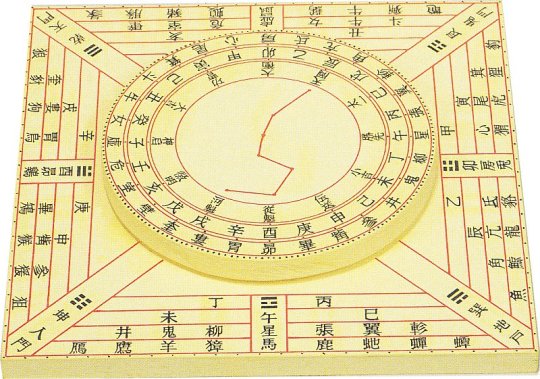
An example of shikiban, the divination board used in rikujin-shikisen (Museum of Kyoto, via onmarkproductions.com; reproduced here for educational purposes only)
A common view is that shikigami originate as a symbolic representation of the power of shikisen (式占) or more specifically rikujin-shikisen (六壬式占), the most common form of divination in onmyōdō. It developed from Chinese divination methods in the Nara period, and remained in the vogue all the way up to the sixteenth century, when it was replaced by ekisen (易占), a method derived from the Chinese Book of Changes.
Shikisen required a special divination board known as shikiban (式盤), which consists of a square base, the “earth panel” (地盤, jiban), and a rotating circle placed on top of it, the “heaven panel” (天盤, tenban). The former was marked with twelve points representing the signs of the zodiac and the latter with representations of the “twelve guardians of the months” (十二月将, jūni-gatsushō; their identity is not well defined). The heaven panel had to be rotated, and the diviner had to interpret what the resulting combination of symbols represents. Most commonly, it was treated as an indication whether an unusual phenomenon (怪/恠, ke) had positive or negative implications.
It’s worth pointing out that in the middle ages the shikiban also came to be used in some esoteric Buddhist rituals, chiefly these focused on Dakiniten, Shōten and Nyoirin Kannon. However, they were only performed between the late Heian and Muromachi periods, and relatively little is known about them. In most cases the divination board was most likely modified to reference the appropriate esoteric deities.
Shikigami take 2: cognitive abilities
While the view that shikigami represented shikisen is strengthened by the fact both terms share the kanji 式, a variant writing, 識神, lead to the development of another proposal. Since the basic meaning of 識 is “consciousness”, it is sometimes argued that shikigami were originally an “anthropomorphic realization of the active psychological or mental state”, as Caroline Pang put it - essentially, a representation of the will of an onmyōji. Most of the potential evidence in this case comes from Buddhist texts, such as Bosatsushotaikyō (菩薩処胎経).
However, Bernard Faure assumes that the writing 識神 was a secondary reinterpretation, basically a wordplay based on homonymy. He points out the Buddhist sources treat this writing of shikigami as a synonym of kushōjin (倶生神). This term can be literally translated as “deities born at the same time”. Most commonly it designates a pair of minor deities who, as their name indicates, come into existence when a person is born, and then records their deeds through their entire life. Once the time for Enma’s judgment after death comes, they present him with their compiled records. It has been argued that they essentially function like a personification of conscience.
Shikigami take 3: energy
A further speculative interpretation of shikigami in scholarship is that this term was understood as a type of energy present in objects or living beings which onmyōji were believed to be capable of drawing out and harnessing to their ends. This could be an adaptation of the Daoist notion of qi (氣). If this definition is correct, pieces of paper or wooden instruments used in purification ceremonies might be examples of objects utilized to channel shikigami.
The interpretation of shikigami as a form of energy is possibly reflected in Konjaku Monogatari in the tale The Tutelage of Abe no Seimei under Tadayuki. It revolves around Abe no Seimei’s visit to the house of the Buddhist monk Kuwanten from Hirosawa. Another of his guests asks Seimei if he is capable of killing a person with his powers, and if he possesses shikigami. He affirms that this is possible, but makes it clear that it is not an easy task. Since the guests keep urging him to demonstrate nonetheless, he promptly demonstrates it using a blade of grass. Once it falls on a frog, the animal is instantly crushed to death. From the same tale we learn that Seimei’s control over shikigami also let him remotely close the doors and shutters in his house while nobody was inside.
Shikigami take 4: curse
As I already mentioned, arts which can be broadly described as magic - like the already mentioned jujutsu or juhō (呪法, “magic rituals”) - were regarded as a core part of onmyōji’s repertoire from the Heian period onward. On top of that, the unlicensed onmyōji were almost exclusively associated with curses. Therefore, it probably won’t surprise you to learn that yet another theory suggests shikigami is simply a term for spells, curses or both. A possible example can be found in Konjaku Monogatari, in the tale Seimei sealing the young Archivist Minor Captains curse - the eponymous curse, which Seimei overcomes with protective rituals, is described as a shikigami.

Kunisuda Utagawa's illustration of an actor portraying Dōman in a kabuki play (wikimedia commons)
Similarities between certain descriptions of shikigami and practices such as fuko (巫蠱) and goraihō (五雷法) have been pointed out. Both of these originate in China. Fuko is the use of poisonous, venomous or otherwise negatively perceived animals to create curses, typically by putting them in jars, while goraihō is the Japanese version of Daoist spells meant to control supernatural beings, typically ghosts or foxes. It’s worth noting that a legend according to which Dōman cursed Fujiwara no Michinaga on behalf of lord Horikawa (Fujiwara no Akimitsu) involves him placing the curse - which is itself not described in detail - inside a jar.
Mitsuki Ueno notes that in the Kōchi Prefecture the phrase shiki wo utsu, “to strike with a shiki”, is still used to refer to cursing someone. However, shiki does not necessarily refer to shikigami in this context, but rather to a related but distinct concept - more on that later.
Shikigami take 5: supernatural being
While all four definitions I went through have their proponents, yet another option is by far the most common - the notion of shikigami being supernatural beings controlled by an onmyōji. This is essentially the standard understanding of the term today among general audiences. Sometimes attempts are made to identify it with a specific category of supernatural beings, like spirits (精霊, seirei), kijin or lesser deities (下級神, kakyū shin). However, none of these gained universal support. Generally speaking, there is no strong indication that shikigami were necessarily imagined as individualized beings with distinct traits.
The notion of shikigami being supernatural beings is not just a modern interpretation, though, for the sake of clarity. An early example where the term is unambiguously used this way is a tale from Ōkagami in which Seimei sends a nondescript shikigami to gather information. The entity, who is not described in detail, possesses supernatural skills, but simultaneously still needs to open doors and physically travel.
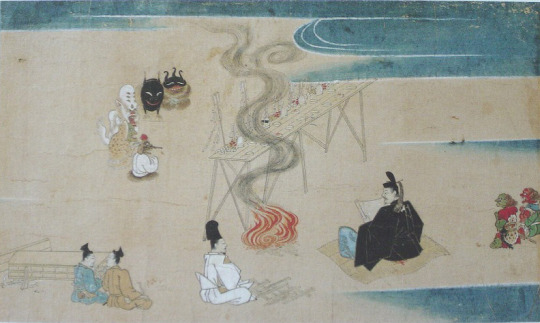
An illustration from Nakifudō Engi Emaki (wikimedia commons)
In Genpei Jōsuiki there is a reference to Seimei’s shikigami having a terrifying appearance which unnerved his wife so much he had to order the entities to hide under a bride instead of residing in his house. Carolyn Pang suggests that this reflects the demon-like depictions from works such as Abe no Seimei-kō Gazō (安倍晴明公画像; you can see it in the Heian section), Fudōriyaku Engi Emaki and Nakifudō Engi Emaki.
Shikigami and related concepts
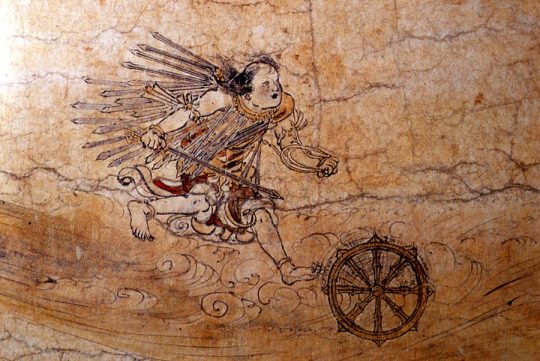
A gohō dōji, as depicted in the Shigisan Engi Emaki (wikimedia commons)
The understanding of shikigami as a “spirit servant” of sorts can be compared with the Buddhist concept of minor protective deities, gohō dōji (護法童子; literally “dharma-protecting lads”). These in turn were just one example of the broad category of gohō (護法), which could be applied to virtually any deity with protective qualities, like the historical Buddha’s defender Vajrapāṇi or the Four Heavenly Kings.
A notable difference between shikigami and gohō is the fact that the former generally required active summoning - through chanting spells and using mudras - while the latter manifested on their own in order to protect the pious. Granted, there are exceptions. There is a well attested legend according to which Abe no Seimei’s shikigami continued to protect his residence on own accord even after he passed away. Shikigami acting on their own are also mentioned in Zoku Kojidan (続古事談). It attributes the political downfall of Minamoto no Takaakira (源高明; 914–98) to his encounter with two shikigami who were left behind after the onmyōji who originally summoned them forgot about them.
A degree of overlap between various classes of supernatural helpers is evident in texts which refer to specific Buddhist figures as shikigami. I already brought up the case of the kushōjin earlier. Another good example is the Tendai monk Kōshū’s (光宗; 1276–1350) description of Oto Gohō (乙護法). He is “a shikigami that follows us like the shadow follows the body. Day or night, he never withdraws; he is the shikigami that protects us” (translation by Bernard Faure). This description is essentially a reversal of the relatively common title “demon who constantly follow beings” (常随魔, jōzuima). It was applied to figures such as Kōjin, Shōten or Matarajin, who were constantly waiting for a chance to obstruct rebirth in a pure land if not placated properly.

The Twelve Heavenly Generals (Tokyo National Museum, via wikimedia commons)
A well attested group of gohō, the Twelve Heavenly Generals (十二神将, jūni shinshō), and especially their leader Konpira (who you might remember from my previous article), could be labeled as shikigami. However, Fujiwara no Akihira’s description of onmyōji skills evidently presents them as two distinct classes of beings.

A kuda-gitsune, as depicted in Shōzan Chomon Kishū by Miyoshi Shōzan (Waseda University History Museum; reproduced here for educational purposes only)
Granted, Akihira also makes it clear that controlling shikigami and animals are two separate skills. Meanwhile, there is evidence that in some cases animal familiars, especially kuda-gitsune used by iizuna (a term referring to shugenja associated with the cult of, nomen omen, Iizuna Gongen, though more broadly also something along the lines of “sorcerer”), were perceived as shikigami.
Beliefs pertaining to gohō dōji and shikigami seemingly merged in Izanagi-ryū, which lead to the rise of the notion of shikiōji (式王子; ōji, literally “prince”, can be another term for gohō dōji). This term refers to supernatural beings summoned by a ritual specialist (祈祷師, kitōshi) using a special formula from doctrinal texts (法文, hōmon). They can fulfill various functions, though most commonly they are invoked to protect a person, to remove supernatural sources of diseases, to counter the influence of another shikiōji or in relation to curses.
Tenkeisei, the god of shikigami
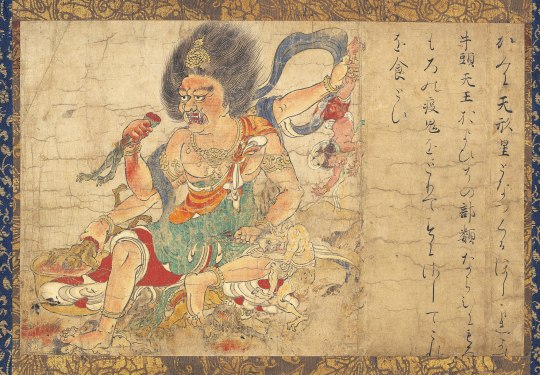
Tenkeisei (wikimedia commons)
The final matter which warrants some discussion is the unusual tradition regarding the origin of shikigami which revolves around a deity associated with this concept.
In the middle ages, a belief that there were exactly eighty four thousand shikigami developed. Their source was the god Tenkeisei (天刑星; also known as Tengyōshō). His name is the Japanese reading of Chinese Tianxingxing. It can be translated as “star of heavenly punishment”. This name fairly accurately explains his character. He was regarded as one of the so-called “baleful stars” (凶星, xiong xing) capable of controlling destiny. The “punishment” his name refers to is his treatment of disease demons (疫鬼, ekiki). However, he could punish humans too if not worshiped properly.
Today Tenkeisei is best known as one of the deities depicted in a series of paintings known as Extermination of Evil, dated to the end of the twelfth century. He has the appearance of a fairly standard multi-armed Buddhist deity. The anonymous painter added a darkly humorous touch by depicting him right as he dips one of the defeated demons in vinegar before eating him. Curiously, his adversaries are said to be Gozu Tennō and his retinue in the accompanying text. This, as you will quickly learn, is a rather unusual portrayal of the relationship between these two deities.
I’m actually not aware of any other depictions of Tenkeisei than the painting you can see above. Katja Triplett notes that onmyōdō rituals associated with him were likely surrounded by an aura of secrecy, and as a result most depictions of him were likely lost or destroyed. At the same time, it seems Tenkeisei enjoyed considerable popularity through the Kamakura period. This is not actually paradoxical when you take the historical context into account: as I outlined in my recent Amaterasu article, certain categories of knowledge were labeled as secret not to make their dissemination forbidden, but to imbue them with more meaning and value.
Numerous talismans inscribed with Tenkeisei’s name are known. Furthermore, manuals of rituals focused on him have been discovered. The best known of them, Tenkeisei-hō (天刑星法; “Tenkeisei rituals”), focuses on an abisha (阿尾捨, from Sanskrit āveśa), a ritual involving possession by the invoked deity. According to a legend was transmitted by Kibi no Makibi and Kamo no Yasunori. The historicity of this claim is doubtful, though: the legend has Kamo no Yasunori visit China, which he never did. Most likely mentioning him and Makibi was just a way to provide the text with additional legitimacy.
Other examples of similar Tenkeisei manuals include Tenkeisei Gyōhō (天刑星行法; “Methods of Tenkeisei Practice”) and Tenkeisei Gyōhō Shidai (天刑星行法次第; “Methods of Procedure for the Tenkeisei Practice”). Copies of these texts have been preserved in the Shingon temple Kōzan-ji.
The Hoki Naiden also mentions Tenkeisei. It equates him with Gozu Tennō, and explains both of these names refer to the same deity, Shōki (商貴), respectively in heaven and on earth. While Shōki is an adaptation of the famous Zhong Kui, it needs to be pointed out that here he is described not as a Tang period physician but as an ancient king of Rajgir in India. Furthermore, he is a yaksha, not a human. This fairly unique reinterpretation is also known from the historical treatise Genkō Shakusho.
Post scriptum
The goal of this article was never to define shikigami. In the light of modern scholarship, it’s basically impossible to provide a single definition in the first place. My aim was different: to illustrate that context is vital when it comes to understanding obscure historical terms. Through history, shikigami evidently meant slightly different things to different people, as reflected in literature. However, this meaning was nonetheless consistently rooted in the evolving perception of onmyōdō - and its internal changes. In other words, it reflected a world which was fundamentally alive.
The popular image of Japanese culture and religion is often that of an artificial, unchanging landscape straight from the “age of the gods”, largely invented in the nineteenth century or later to further less than noble goals. The case of shikigami proves it doesn’t need to be, though. The malleable, ever-changing image of shikigami, which remained a subject of popular speculation for centuries before reemerging in a similar role in modern times, proves that the more complex reality isn’t necessarily any less interesting to new audiences.
Bibliography
Bernard Faure, A Religion in Search of a Founder?
Idem, Rage and Ravage (Gods of Medieval Japan vol. 3)
Makoto Hayashi, The Female Christian Yin-Yang Master
Jun’ichi Koike, Onmyōdō and Folkloric Culture: Three Perspectives for the Development of Research
Irene H. Lin, Child Guardian Spirits (Gohō Dōji) in the Medieval Japanese Imaginaire
Yoshifumi Nishioka, Aspects of Shikiban-Based Mikkyō Rituals
Herman Ooms, Yin-Yang's Changing Clientele, 600-800 (note there is n apparent mistake in one of the footnotes, I'm pretty sure the author wanted to write Mesopotamian astronomy originated 4000 years ago, not 4 millenia BCE as he did; the latter date makes little sense)
Carolyn Pang, Spirit Servant: Narratives of Shikigami and Onmyōdō Developments
Idem, Uncovering Shikigami. The Search for the Spirit Servant of Onmyōdō
Shin’ichi Shigeta, Onmyōdō and the Aristocratic Culture of Everyday Life in Heian Japan
Idem, A Portrait of Abe no Seimei
Katja Triplett, Putting a Face on the Pathogen and Its Nemesis. Images of Tenkeisei and Gozutennō, Epidemic-Related Demons and Gods in Medieval Japan
Mitsuki Umeno, The Origins of the Izanagi-ryū Ritual Techniques: On the Basis of the Izanagi saimon
Katsuaki Yamashita, The Characteristics of On'yōdō and Related Texts
117 notes
·
View notes
Text
No MAO chapter today..
No Shonen Sunday this week, so no new chapter of MAO!However we'are longing for something exciting. So let's take looks on 2017's A Thousand Years of Innocence (千年の無心), which has many precursors to MAO.
This short story of Rumiko sama is one of action,school life,murder mystery and romance. No slpstick.He he he:)
Synopsis:
In modern Japan school girl Ai is harassed by her classmates,being scorned about a scar on her cheeks. Suddenly weird pieces of wood,with written spells on them, are about to kill all of them.But the immediate intervention of a strange young man saves them. And miraculously Ai's scar is wiped out,thanks to the man's blood.An adventure rife of mystery gets unfolded...
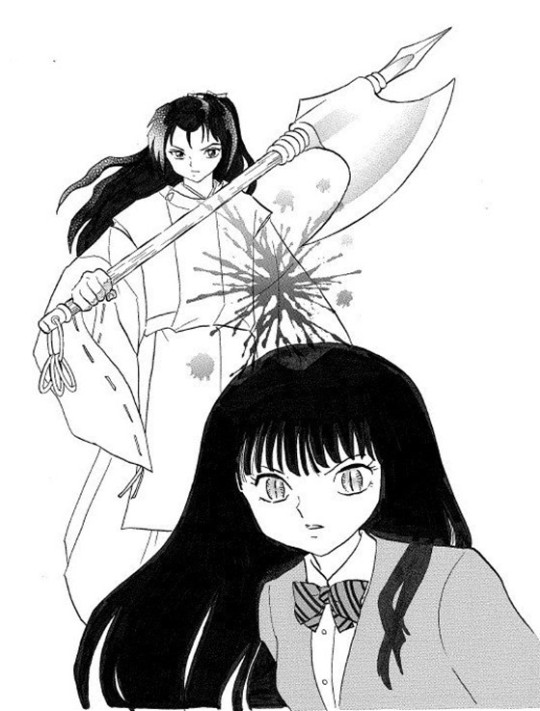

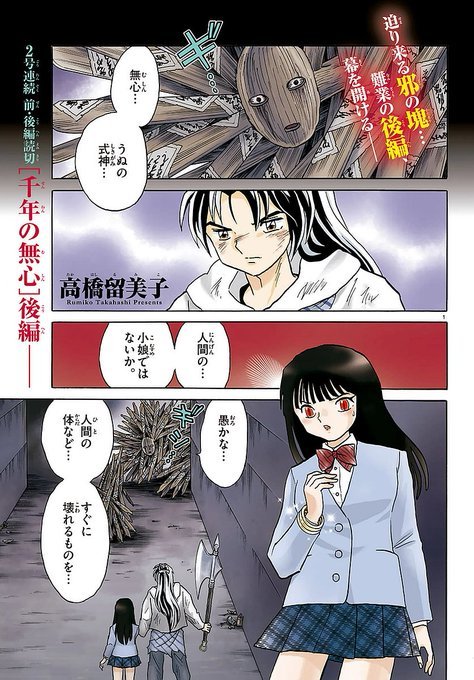
#Takahashi Rumiko#高橋 留美子#千年の無心#A Thousand Years of Innocence#MAO manga#school life#dark fantasy#onmyodo#Heian era#平安時代#Shogakukan manga#Weekly Shōnen Sunday#週刊少年サンデー#マオ#株式会社小学館#I Love Japan#日本が大好きです#愛
2 notes
·
View notes
Text
Onmyodo at Philly Otaku Con

Really nice time running demos of Onmyodo at last month's Philly Otaku Con, a truly awesome convention right on the Philadelphia waterfront!
#onmyoji#yokai#japanese folklore#anime convention#gaming convention#philadelphia conventions#solo games#board game demos#onmyodo#shinto#cardgames
8 notes
·
View notes
Text

I made this Nanoka and Natsuno Quick sketch. It's Nice that for Good motives Natsuno is alike to Mother treating to Nanoka.
#MAO fanart#Takahashi Rumiko#高橋 留美子#マオ#Kiba Nanoka#黄葉 菜花#夏野#Mao Natsuno#Onmyodo#Heian era#Time travel#Taishou era#Akanemaru#地血丸#Onmyouji clothing#Earth user Natsuno
0 notes
Text
i made something stupid. rb and put in the tags (or screenshot) your results and what you think the game you got would be like.
#shindanmaker#generator#random generator#mobile games#gacha games#genshin impact#arknights#fgo#honkai star rail#nikke goddess of victory#girl's frontline#blue archive#alchemy stars#(random fandoms so it reaches target audience)#i personally got onmyoji live and i think it would have been okay??? f2p friendly & made in europe for china lmao. but closing soon. rip#the onmyodo guys kill each other on stage
10 notes
·
View notes
Text

General information about Jade's onmyodo verse:
Born in the Coral Sea, 4th son of King Antonio the Usurper.
He is twin to Floyd, 5th son of King Antonio.
He has 3 older sisters, 1 younger brother, and 1 younger sister (Floyd excluded)
Though both his younger brother and sister are over a hundred years old, they possess the appearance of a toddler and are still considered young mermaids among merfolk.
Not all of Jade and his siblings share the same mother.
There is a saying that Antonio murdered his twin brother, Jacques, the true king of the Coral Sea, and crowned himself king. The other kingdoms in the sea are divided between kingdoms that recognize Antonio as the rightful ruler of the Coral Sea and form a decent friendship with them, others refuse to recognize Antonio's rule and have a strained relationship with Antonio and his family.
The eldest princess is the Crown Princess of the Coral Sea, although some say that Jade is the true Crown Prince for being the eldest son.
Neither members of the family have either confirmed or denied any of these claims, preferring them to roam the kingdoms as rumors.
The most prominent crafts in the Coral Sea are jewelry-making and potion-making. They export a huge variety of ocean jewelry and potions across the world.
One example of the beauty of jewelry from the Coral Sea is that its merfolk are able to capture the moonlight and forge it into crystal gems, which are later turned into earrings or necklaces, this reason being why their jewelries are highly recognizable regardless of where it's being sold to.
The beaches of the Coral Sea are known as the Tear-Washed Sands due to the way they glow blue during the night. The blue sparkles are remains of the tears of merfolk in the Coral Sea that have hardened after they died and washed ashore.
#𖦹 ⋆꙳ ⟡ ⁄ ᴍᴇᴇᴛ ᴍᴇ ᴡʜᴇʀᴇ ᴛʜᴇ sᴋʏ ᴛᴏᴜᴄʜᴇs ᴛʜᴇ sᴇᴀ *:・ ONMYODO AU.#// posts this to enable some people then runs away
13 notes
·
View notes
Text
i fell into a little rabbit hole while reading bora chung's cursed bunny when i found the japanese proverb 「人ひとを呪のろわば穴あな二ふたつ」 ("hito o norowaba ana futatsu"), meaning "when you curse a man, [you dig] two graves" (click here for reference and click on the first link at the bottom for more context). it's a cautionary proverb about the consequences of cursing or invoking evil onto others, similar in a way to the english proverb "what goes around comes around."
i dug around some more (hah!) and found an article explaining the origins of the proverb (click on the second link at the bottom). do bear with my lacking skills when it comes to translating, but from what i understand, the proverb itself originated from the heian period. onmyoji (click on the third link at the bottom) were civil servants who practiced onmyodo, specializing in magic and divination. the article describes them using the kanji 呪術師 (third highlight in the left image), or jujutsushi, meaning sorcerer.

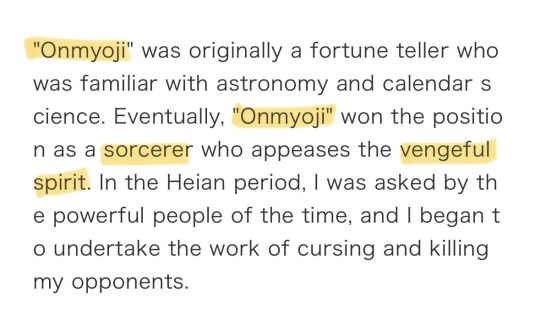
these onmyoji were responsible for calendar-related tasks and mystical duties such as divination, but the most interesting duty listed was protecting the capital from evil spirits, or 怨霊を (vengeful spirit) as the article cites, by cursing and killing the capital's opponents. now, this was a particularly dangerous task because they risked having that curse "returned" back to them in a counter-attack, killing them in the process, too—hence why one must prepare two graves when one resorts to "cursing" someone.
now that we've established the history of the proverb, it initially struck me as familiar because...
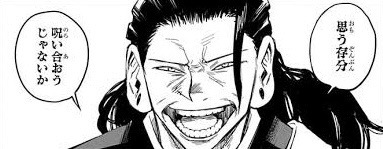

it's something geto mentioned when he came to the school to declare war! and...


later on when he says his last words to gojo!
given that the series takes some inspiration from onmyodo in the heian period (the golden age of jujutsu in the story), it's befitting that a proverb like this would make an appearance in the actual dialogue. in both instances, the proverb was relevant in geto's dialogue.
the article i referred to before also provided two example sentences related to the proverb, which when translated become:
"As there is a saying that if you curse people, there are two graves, hatred only produces unhappiness."
"I hate him so much. Even if you say that if you curse people, you will have two graves, I'm prepared for that."
as the geto fanatic that i am i find it interesting that both these phrases could align with geto's lines in volume 0. the first time geto references this proverb, it's when he says, "let's curse each other to our hearts' content." i've talked about this in my other posts (click here for one of them), that i've always believed that geto knew his pursuit of ideal was futile, or "impossible" as he explained to gojo in shinjuku. regardless of the outcome, this was the path he chose for himself, a path where he had to constantly pretend to the people around him that it was indeed possible.
referring to the proverb, the two graves here would be geto and the subject of his curse, non-sorcerers. his curse—his hatred—only led to his own unhappiness and his own demise. as it is, he failed his attack and the only grave there was his. he died unable to laugh from the bottom of his heart.
the second time geto references this proverb, it's when he says, "at least curse at me a little at the very end." he says this in an easy exasperation in response to gojo's omitted last words to him. he expects gojo to hate him or at least be angry with him, but instead gojo does not "curse" him the way he thought he'd be.
refering to the proverb, geto expects gojo to hate him so much, he'd curse him even if it might risk his own life to see geto dead. instead, gojo spares him—or rather, gojo says what he says honestly, without the disguise of anger or spite. the two graves here, at least in geto's mind, would be gojo and the subject of his curse, geto himself. ironically, despite the lack of "curse," there is still a grave for one body. in a more figurative sense, perhaps that alley is a teeming graveyard.
what an apt cautionary proverb for such a vengeful character.
links i couldn't hyperlink:
#jjk#jujutsu kaisen#geto#gojo#satosugu#lobotomy kaisen#icb i see them everywhere#well at least i'm packed with more knowledge#i logged into jstor (for naught but a simple proverb but it was still fun)#why cannot i hyperlink#jjk meta
47 notes
·
View notes
Note
Hi! I recently got into reading some of your fanfics via Ao3 and ff.net. I instantly fell in love with Ayame and her chaotic nature. I was wondering if it would be possible if we could get a overview on her and her many abilities. If possible of course, Pls and thank you!
ANON YOU HAVE MADE MY *DAY*
I'm always down to talk about Ayame!
As a character, Ayame has basically 2 rules.
Nothing is impossible for her*
She's stronger and smarter than anyone else.
*There are things that she won't do and thus will lie to your face and say it's impossible. If it's truly impossible, then it's like... "shatter reality if it's done" type possible and then survival > "it's possible" wins.
Because I toss her into multiple fandoms, she always scales a little with said fandom. And as I discovered with the KNY fic with her, putting her in fandom where the balance is off makes for a boring fic.
Ayame (Tier and Asher too) whole concept is to be the most OP, curbstomping, there's nothing they can't do, type characters. They have their strengths and weakness of course. Tier and Asher essentially fill in the gaps in Ayame and vice versa. There's no limit, except perhaps some logical limits.
For example, it's not impossible for Ayame to build a time machine, but if you need a time machine RIGHT THIS INSTANT, she can't just snap her fingers and have on made instantly. She might come up with the design right away, but between testing and physically having to build one, it'll take days. (Or a day at least)
Abilities
Ayame's base kit includes
Sight
Onmyodo
Portals
Sight, despite it's name, is not reliant on sight only. wwbtf is the only fic I wrote that really goes into it, but essentially just like how shrimp can see colors we can't, Ayame's view on the world is a little more skewed than others. She sees/hears/feels/senses/tastes/smells things we can't. Goes from anything from ghosts to fate strings to seeing the future and past to dreams to aura and more.
Onmyodo, Ayame grew up on a shrine. Her father was a powerful priest. So she's got all the normal rituals, basic purification and blessings and more down.
Portals, Ayame has the ability to anywhere she wants to be.
That's it. No, seriously. That's it.
Ayame's OPness comes from the fact that the "power system" from her world is highly flexible and compatible AND Ayame understands the truth of the system on top of being a genius.
FFXV calls it magic, KHR calls it Dying Will Flames, at the end of the day, to Ayame, it's a type of energy that you produce from your soul and since she produces that type of energy, she can use any technique you use with higher efficiency and more power and better understanding probably.
And when it comes to raw output of that same energy, she got more than anyone else in the entire universe.
But what about the gravity power she always uses in fics?
That's Engetsu's power :D
And her weapon?
:D
#seitoocs#bitsverse#seitowrites#i love getting asks about my ocs#please always feel free to send more
19 notes
·
View notes
Text
💮 onmyōji (2023) review 💮
it took me longer than expected to finish this highly-anticipated adaptation, but boy am i glad i completed it!
first up, i just wanna say i have only read a few chapters of the stories by yumemakura baku, and and only seen snippets of the 2001 movie. i've not seen the sequel, nor the chinese adaptations (and certainly not played the games). that said, i am very familiar with onmyodo and its place and significance in japanese history and culture, since there are overlaps between it and taoism, buddhism, and east asian divination in general.
with that in mind, i was pleasantly surprised at how the anime eased viewers into the philosophies behind onmyodo, particularly with the concept of curses, the birth of demons, and rituals; everything was explained very clearly, with hiromasa as a stand-in for the audience, although i did wish that the show dwelled more on the supernatural aspects during the first few episodic arcs.
likewise, i enjoyed the relationship between seimei and hiromasa; and here is where the stans could fill me in, because i was very certain that the 2001 movies weren't as fruity as the anime. but still, the message was received, and i was very pleased with how their relationship was depicted – hiromasa being soft and very attuned with his emotions was a very heian gentlemanly trait to have, so it didn't feel out of place at all.
personally, i think the final arc could have explored more of hiromasa's death on seimei, but i think that short scene (barely a few seconds!) of seimei cradling hiromasa's sword was molto bene.
in terms of animation, i found it satisfactory; clearly a higher budget would have done the special effects more justice, but given that the onmyoji were more priests and academicians than jujutsu kaisen sorcerers, the relatively modest show of their abilities made sense. i will say, there were key frames in episode 4, especially with certain profiles and oblique angles, that looked rough.
the final three episode were beautifully animated though! and i adored the ending theme and animation!
also, this is just me being a mardy bum, but i think this would've worked better as a spring/summer anime than a fall/winter one, given the gorgeous floral motifs (although the cold seasons have always evoked intense fujo feels inside of me haha).
in all, as with ooku: the inner chambers, which aired a few months ago, i will not be object to a second season of this show – namikawa daisuke and asanuma shintaro did splendidly as seimei and hiromasa, and i would certainly love to see the other stories animated!
#i understand that this show currently shares a tag with onmyoji the game so i propose#onmyoji netflix#as a tag#likewise we could use#yumemakura baku's onmyoji#onmyoji#onmyoji 2023#abe no seimei#minamoto no hiromasa#yumemakura baku
35 notes
·
View notes
Note
Do you know why Abe-no-Seimei became so popular compared to any other onmyoji in folklore and literature? Is it because of who wrote his stories or something else?
There is no single clear answer. It seems safe to say there are multiple interconnected factors at play.
Seimei’s real career was genuinely extraordinary in some regards. To begin with, it was unusually long. He was around 85 years old when he passed away, and historical sources would indicate that he was still fairly active in old age (in fact, most references to him which are fully verifiable come from the second half of his life). Shin’ichi Shigeta actually argues here that Seimei's longevity in no small part contributed to cementing his legend.
However, it’s hard to argue that the times when Seimei lived were not a factor in its own right too. Institutional backing was no longer the sole reason behind the relevance of individual onmyōji. As I discussed in my recent article, by the middle of the tenth century their clientele expanded. And to find new clients, personal charisma was necessary.
The shift started slightly earlier already but it doesn’t seem like the likes of Shigeoka no Kawahito or Kamo no Tadayuki left quite as much of an impression as Seimei and his contemporary Kamo no Yasunori in the long run. Legends do deal with earlier onmyōji at times, or rather reinvent earlier figures, especially Kibi no Makibi, as onmyōji, but this is often merely a way to make Seimei’s or Yasunori’s deeds appear even more amazing by making them a part of centuries old legacies (granted, standalone tales of Makibi appear for example in Konjaku Monogatari already).
Seimei’s personal influence is evident in the fact that he seemingly was responsible for popularizing formerly obscure Taizan Fukun no sai as one of the main onmyōdō rituals (check Shigeta’s article above for more specific evidence). Note that this was a performance so popular the early medieval reinterpretation of Amaterasu was in no small part driven by efforts to make her fit into rituals similar to it and Enmaten-ku. There’s also evidence that Seimei had an impact on the popularity of tsuina, a ceremony originally held only in the court but later also in private houses of nobles which served as a forerunner of modern setsubun.
The Abe clan remained influential in official onmyōdō circles long after Seimei’s death, and his heirs obviously invoked his fame to validate their own influence. There are texts only compiled after the Heian period which were attributed to him, such as Hoki Naiden. This obviously further contributed to the spread of his legend, making him relevant even as onmyōdō changed.
I don’t think it matters who wrote down the legends though, at least not before the Edo period. However, there are at least some individual elements which absolutely became such a mainstay of modern portrayals of Seimei because of the fame of specific authors who introduced and/or popularized them. A good example would be the Kuzunoha story, which was only invented in the 1600s and attained popularity because of Ryōi Asai’s Abe no Seimei Monogatari (I am not aware of any older legend claiming Seimei was not fully human, unless you want to count the Shuten Dōji variants presenting him as a manifestation of Kannon or Nagarjuna).
Another thing which comes to mind as an example of influence of specific works of fiction is portraying Dōman as older than Seimei, which is a convention started by Edo period theatrical performances as far as I know. Dōman's historical counterpart was pretty obviously younger (granted, there's also no evidence he interacts with Seimei). He was still active three years after Seimei’s death, and there’s no indication he was somehow 90+ years old.
Bit of a digression but it’s worth noting Dōman isn’t Seimei’s only rival in the early stories, in Konjaku Monogatari he also faces a certain “fearsome fellow” named Chitoku who does seem to be older than him. He is an unlicensed onmyōji and comes from Harima, so it's easy to draw parallels with Dōman. However, they aren’t really similar characters; while Dōman is pretty firmly portrayed as a shady figure - a curse specialist first and foremost - Chitoku actually seems to utilize his skills to deal with pirates troubling his area. He just learns he’s a big fish in a small pond after unsuccessfully challenging Seimei. Still, I wonder if the two may have merged at some point in popular imagination.
27 notes
·
View notes
Photo



I’m doing it for the short story,”Sennen No Mushin(Mindlessness for a thousand-years)” by Rumiko.That’s initial idea leading to MAO.Such Great sory with Mr Mindless and the Japanese school girl Ai.
#Takahashi Rumiko#高橋 留美子#Sennen No Mushin#onmyodo#Heian era#平安時代#action supernatural manga#historical manga#immortal shaman in modern japan#shikigami#式神#MAO manga#マオ
2 notes
·
View notes
Text

The Monkey King Invades Onmyodo!
It's Son Goku aka The Monkey King aka Sun Wukong, one of the more powerful, but chaotic Travelers that can appear in my new game Onmyodo. With his super-staff weapon (worth 3 normal staffs!) and Cloud Fly ability, he can really make a dramatic difference in the group! Though he really lacks in many of the traits required for traveling itself! (Hopefully the rest of the group can help him along...)
Fun fact: one of the Quests in the game is to help an Evolving or Animal Traveler attain Enlightenment. Son Goku fits both of these categories so would be a perfect candidate!
#saiyuki#monkeyking#journeytothewest#onmyoji#onmyodo#monkeymagic#buddhism#card games#solo games#asianheroes#chinesemythology#japanesemythology#yokai#japanesedemons#enlightenment#tripitaka#tang sanzang
7 notes
·
View notes
Text
I was remembering your post about Kiara almost having a heart attack from playing elden ring and being called maidenless and that made me think of this funny scenario: so given that we can fairly safely assume that the servants are banging like they’re athletes in the olympian village, and given that none of them have ever given off “corrupted by an evil nun” vibes, either Kiara can stop being Like That long enough to have a one night stand, or she’s possibly actually getting laid the least out of all the sex-interested servants in Chaldea.
I feel like Andersen would be saving this factoid in order to unleash it on Kiara when he needs to do a max damage critical hit to her.
-------------------------------------------------------------------------
Kiara lives in fear that one day, every one will realize she’s not actually getting any but is just pretending she does, and especially fears that Andersen will be Like That.
Little does she know Murasaki knows, her Commentary Onmyodo already revealed it.
35 notes
·
View notes
Text
MDZS INSP Set Pt1

This is the very first batch of uploads from my TS3 gameplay inspired by Mo Dao Zu Shi / The Untamed!
EA Books Default Replacement

First up is yet another EA Book Default Replacement, this time using Chinese & Japanese themed book textures. Browse here & here for the swatches/in-game pics. The list of replacements is under the cut.
File Dump Part 1

This file dump includes 18 Buy Mode objects:
EA Chinese Tomb Chest as Toy Chest (basegame)
Silfantasy Chinese Sword as Hoverboard (ITF EP)
Tera Bag as Bag of Understanding (WA EP)
Radish as Edible Morsel (WA EP)
Emperor's Smile as Drinkable UNI EP Alcohol (Arsil Custom Beverages mod + UNI EP REQ)
TS4 to TS3 Jennisims Lotus Seed Pod as Edible Morsel (WA EP)
TS2 to TS3 Jizaikagi Irori Edit as Firepit PLAIN
TeeSangBoy Chinese Couch Redone as Decor Bedframe
TS2 to TS3 Asian Ornate End Table
TeeSangBoy Coffee Table TINY
EA Zen Bath Stool Emptied as Coffee Table
TS2 to TS3 Bamboo Copse
Bamboo Wall Stickers
MTCakestore Chinese Books (Stackable)
ShinoKCR Couch Cushion as Scroll Bundle (Stackable)
TS4 to TS3 Chinese Decor Man 1, 2, 3
Pinwheel ACCs
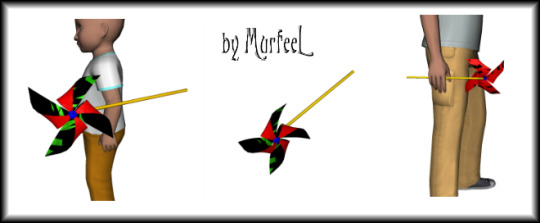
This miniset includes 3 CAS objects:
ATS3 Pinwheel as ACC for Kids, Toddlers & Adults
And that's that for now!
Enjoy, and Happy Lunar New Year 2023! 🐇🐰
Download folder (zip files): Mediafire | SimFileShare
Descriptions & pics under the cut:
EA Books Default Replacement

There are A LOT of books in TS3, so I tried to match Chinese & Japanese books to TS3′s particular genres:
Athletic & Sports: Armor, Book of 5 Rings (Musashi Miyamoto) | PhysEd & Military: Art of War (Sun Tzu) | Martial Arts: Daoist exercise chart | Riding: Yabusame scroll
Charisma 1-3: Genji no Kokagami (Murasaki Shikibu)
Cooking: Lvl 1 (52 Sick Prescriptions), Lvl 2 (Materia Dietetica), Lvl 3 (Herbal Food + Materia Dietetica)
Fishing 1-3: Materia Medica fish & reptiles (Bencao Gangmu)
Gardening: Lvl 1 (E-hon (Utagawa Hiroshige)), Lvl 2 (Court Records of Japanese Gardens), Lvl 3 (Compendium of Model Gardens (Tsukiyama & Yokei))
Generic: Butler (Book of Rites) | China (WA EP) () | Generic 1-3 (Analects (Confucius))
Handy 1-3: Scroll of Mudras
Kids: Children/Toddler Pictures & Comics (UNI EP) (Journey to the West) | Toddler Fun (Japanese Folk Toys) | Toddler Numbers (CHN/JPN numbers) | Toddler Words (Hiragana chart)
Learning: Non-fiction (Nihon Shoki) | AcadTech/Sci (Chinese alchemy) | Math (Third order equation (Shu shu jiu zhang) | Science (Chinese alchemy, ) | AcadFineArts (Analects) | AcadComm (Shuowen Jiezi) | Social (Genji no Kokagami (Murasaki Shikibu)) | Medical/Prenatal (Chinese Pharmacopoeia) | Historical (Book of Documents)
Logic: Lvl 1 (Analects (Confucius)), Lvl 2 (Book of Documents), Lvl 3 () | Poetry (Book of Songs) | AcadBusiness (Art of War (Sun Tzu))
Magic/Spellcraft (SN EP): Lvl 1 (Iching), Lvl 2 (Onmyodo (Abe no Seimei)), Lvl 3 (Iching hexagram)
Masterpiece (Book of Songs) | Photography/Street Art (E-hon (Utagawa Hiroshige))
Music: Lvl 1 (Qinxue Congshu), Lvl 2 (Qinxue Rumen), Lvl 3 (Book of Songs)
Recipe: Lvl 1 (52 Sick Prescriptions), Lvl 2 (Materia Dietetica), Lvl 3 (Herbal Food + Materia Dietetica)
Recreation: English (Bushido (Inazo Notobe)) | Fiction (Tamamo-no-mae (Katsushika Hokusai)) | Fantasy/Humor/Horror (Kyōsai Hyakki Gadan (Kawanabe Kyōsai)) | Biography (Heike Monogatari) | Romance (Genji no Kokagami) | Drama () | SciFi (Kaguya) | Mystery (Gazu Hyakki Yagyō (Toriyama Sekien))
Y'all can scroll through most of the replacements/swatches here & here.
File Dump Part 1
EA Chinese Tomb Chest as Toy Chest (basegame)
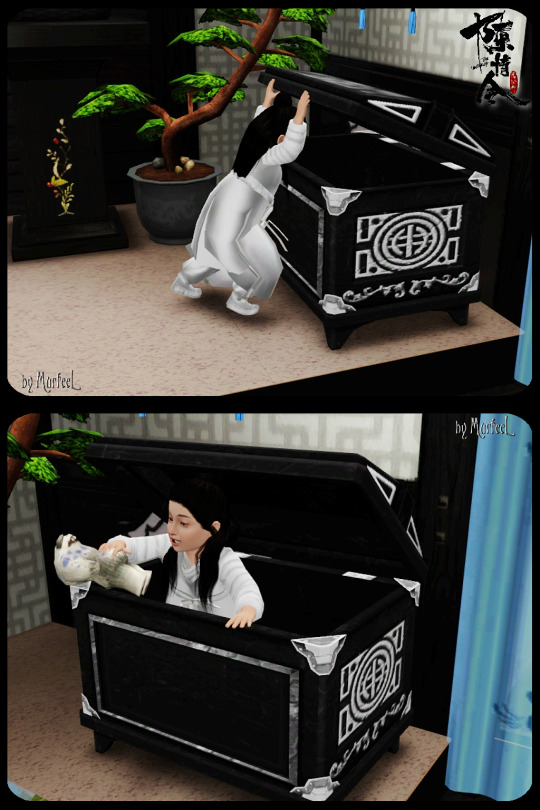
Silfantasy Chinese Sword as Hoverboard (ITF EP)

Tera Bag as Bag of Understanding (WA EP), recolorable, found under Misc Decor IIRC.

Radish as Edible Morsel (WA EP), recolorable; found under Misc Appliances & Plants.
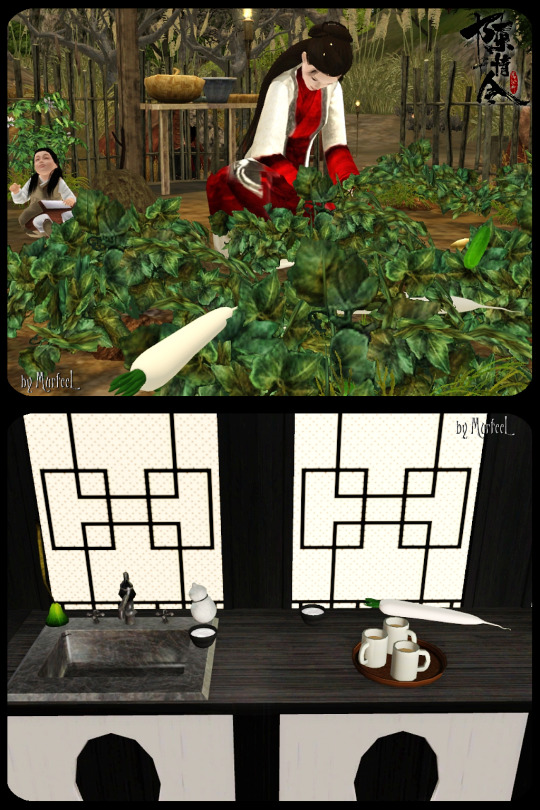
TS4 to TS3 Jennisims Lotus Seed Pod as Edible Morsel (WA EP), recolorable; found under Misc Appliances & Plants.

Emperor's Smile as Drinkable UNI EP Alcohol (Arsil Custom Beverages mod + UNI EP REQ), recolorable; found under Misc Appliances.
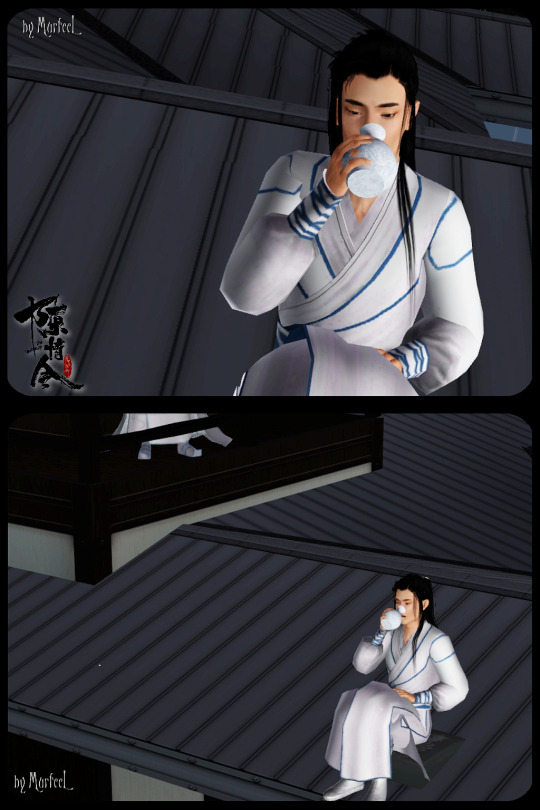
TS2 to TS3 Jizaikagi Irori Edit as Firepit PLAIN is yet another version of my two Jizaikagi Irori (here & here), this time without the hanging rack/shelf.

TeeSangBoy Chinese Couch Redone as Decor Bedframe, to be used with functional mattresses (I used these by Sketchbookpixels).

TS2 to TS3 Asian Ornate End Table, TSB Coffee Table TINY, EA Zen Bath Stool Emptied as Coffee Table all recolorable & self explanatory.
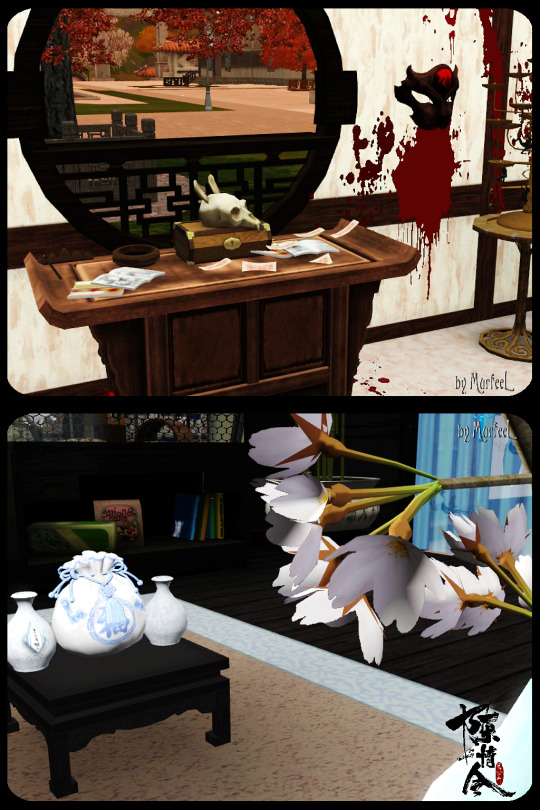
TS2 to TS3 Bamboo Copse recolorable, found under Plants & Lawn Deco. Bamboo Wall Stickers recolorable, under Wall Art.
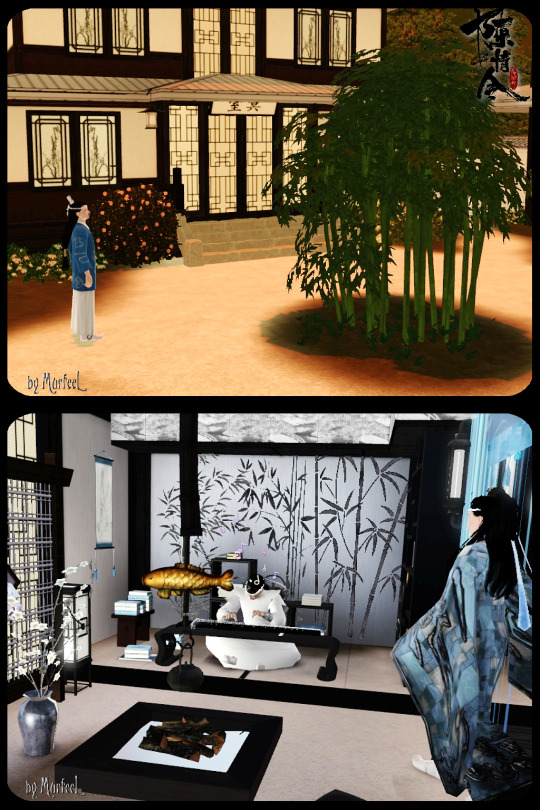
MTCakestore Chinese Books (Stackable) & ShinoKCR Couch Cushion as Scroll Bundle (Stackable) under Misc Deco, fully recolorable.
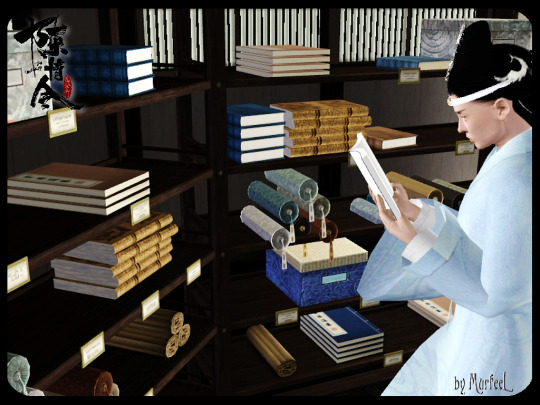
TS4 to TS3 Chinese Decor Man 1, 2, 3 non-recolorable, but includes rainbow of color variations. Found under Sculptures.
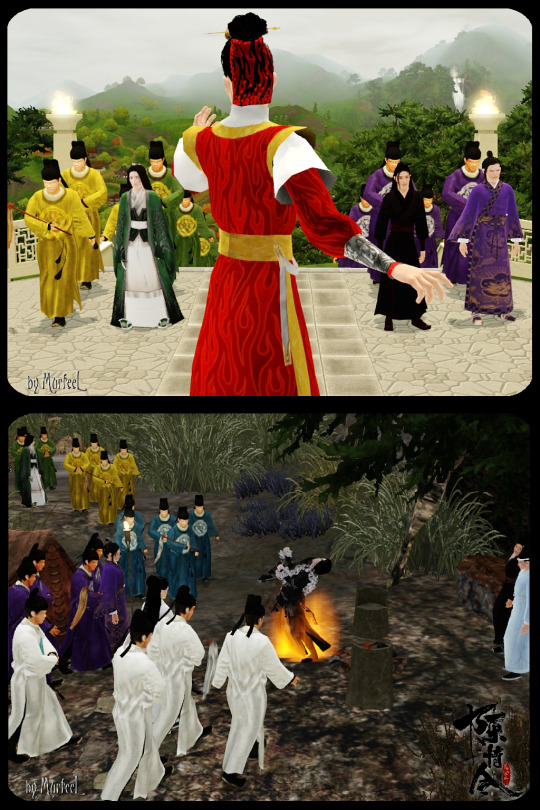
ATS3 Pinwheels as ACCs

Recolorable, unisex for toddlers, children, and teen-elders. Found under Bracelets.
And that's that for now!
Enjoy, and Happy Lunar New Year 2023! 🐇🐰
Download folder (zip files): Mediafire | SimFileShare
#sims 3 cc#sims 3 conversion#ts2 to ts3#ts4 to ts3#sims 3 asian#sims 3 the untamed#sims 3 mdzs#sims 3 accessory#sims 3 mods#sims 3 buy mode#sims 3 foodstuffs#sims 3 plants#sims 3 appliances#sims 3 surfaces#sims 3 toys#sims 3 transportation#sims 3 wall art#sims 3 world adventures#sims 3 into the future
140 notes
·
View notes
Note
✨ for a screenshot associated with magic or aether
(Chad or Kasha, whichever you choose)
aaaaaaaaaaaa i took so long i'm sorryyyyyyy

Kasha's quite well-versed in magic - specifically Onmyodo, a subset similar to summoning, but less about summoning creatures, and more of other magicks. She infuses an inkbrush with her aether, scribing slips of paper with magic incantations, storing the spells for use later. She always carries plenty of prepared ofuda under her robes, lining the inside of every flowing cloth.
Thank you for the ask!
7 notes
·
View notes
Text
I'm really going to make that Onmyodo verse for Jade. It's loosely based on the game Onmyoji but it's primarily more Japanese Mythology and Onmyodo centric in terms of lore/world building.
7 notes
·
View notes